INDIA :
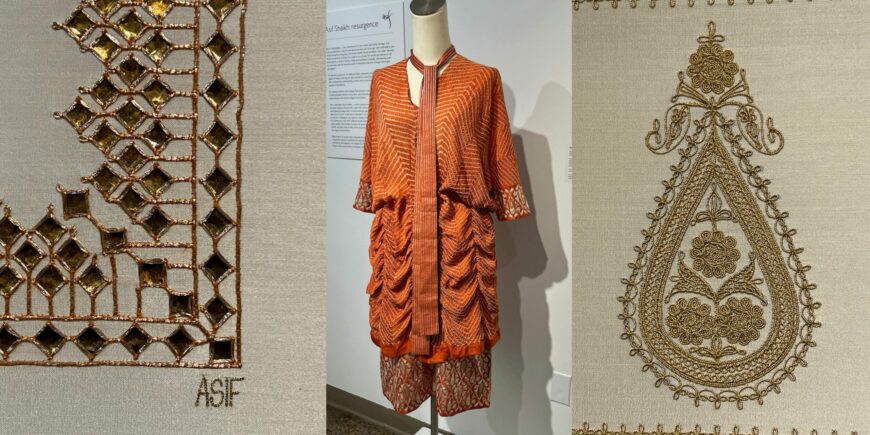
Virtual Exhibition
Featuring the work of Asif Shaikh and his artisan studio
Mary Giles Gallery • April 18 – June 7, 2023
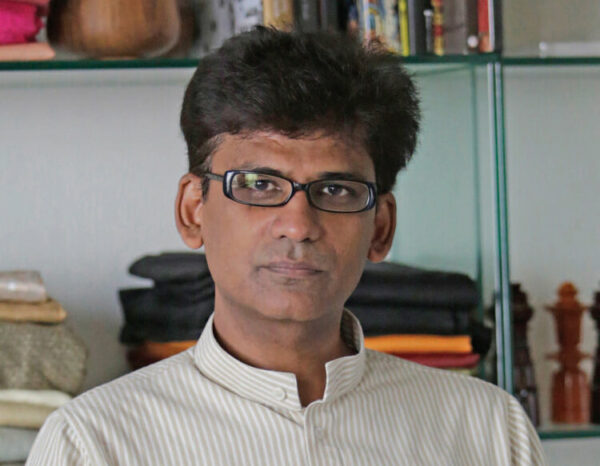
Textile Center is honored to host this special exhibit of work by Asif Shaikh, from Ahmedabad, India. As one of India’s most accomplished and acclaimed embroidery and textile artists and experts, Asif’s incredible embroideries, research, and writing create a bridge between East and West, old and new, tradition and innovation. His intricate and labor intensive artisan stitching “mends” a historic gap in Indian craft through his revival of Mughal (court) embroidery.
This collection of work from his studio highlights his leadership and influence in the revival of India’s textile heritage, focused on hand embroidery. Throughout his life, Asif’s work has developed with a highly refined and deeply held sense of aesthetics, steeped in detailed design and technical tradition. His dedication to the making of the ornate embroideries featured in the exhibition serves is testament to the social and cultural value of embroidery.
Born in Ahmedabad, a city renowned for its rich culture and textile heritage, Asif took up embroidery when he was about ten years old. At an age when embroidery was rarely pursued by young boys, Asif chose needle, thread and fabric over other interests. He explored a spectrum of traditional Indian embroidery techniques from different regions of India by learning the stitch himself, to build a sound technical foundation and fundamental understanding of stitch. Currently, his studio employs artisans who produce a range of embroidered yardage, which is transformed into garments and textiles. Showcasing a sophisticated juxtaposition of contemporary style and traditional textile techniques in stitch, motif, composition, and color palette, these textiles recreate the grandeur and fineness of India’s fabled royal textiles and attire, while reviving and preserving the tradition of Indian embroideries and supporting local artisans.
Reflecting on his sought-after works, Asif says, “Embroidery is what I live for. I will always immerse myself into this mesmerizing world because it gives me utmost satisfaction and happiness. No matter how fanciful, I love to give shape to an idea and bring it to life using timeless techniques with an innovative twist.”
Thanks to Mary Anne Wise for introducing us to Asif’s work and to Shelley Wells for delivering, curating, and installing this exhibition.
_____________________Art Speaks: Resurgence with Asif Shaikh_______________
In this virtual conversation in June 2023, Asif Shaikh joined Textile Center from Ahmedabad, where he presented his work and practice, including his most recent projects.
In this virtual conversation in June 2023, Asif Shaikh joined Textile Center from Ahmedabad, where he presented his work and practice, including his most recent projects.
____________________In the Gallery_________________
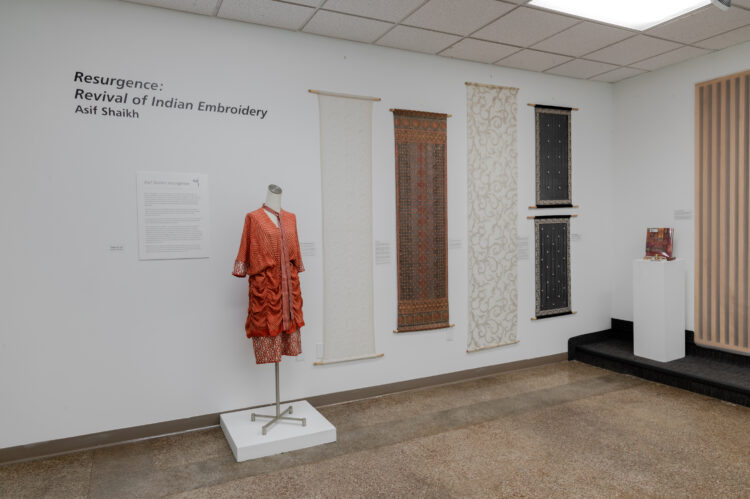
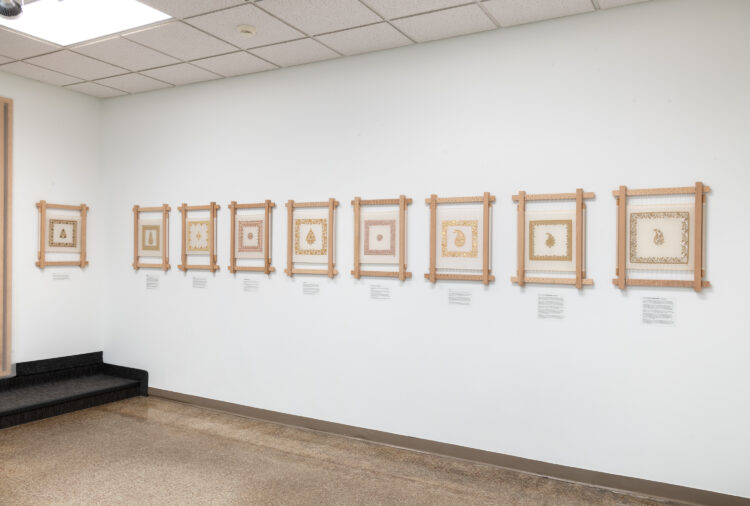
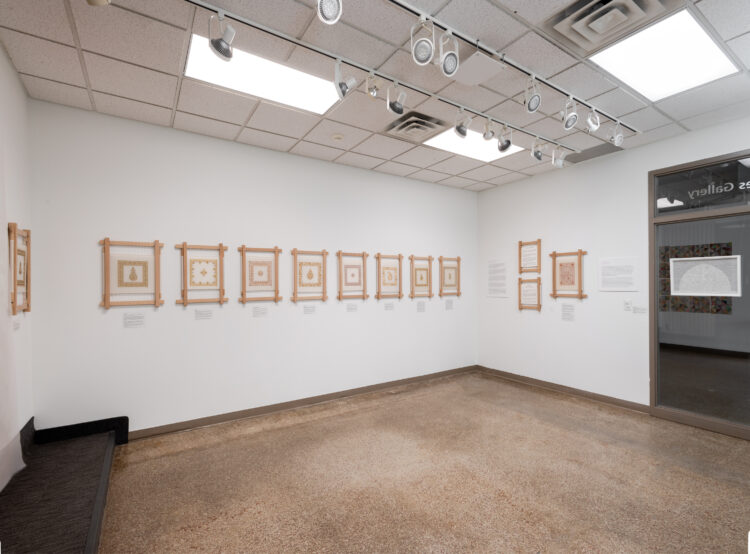
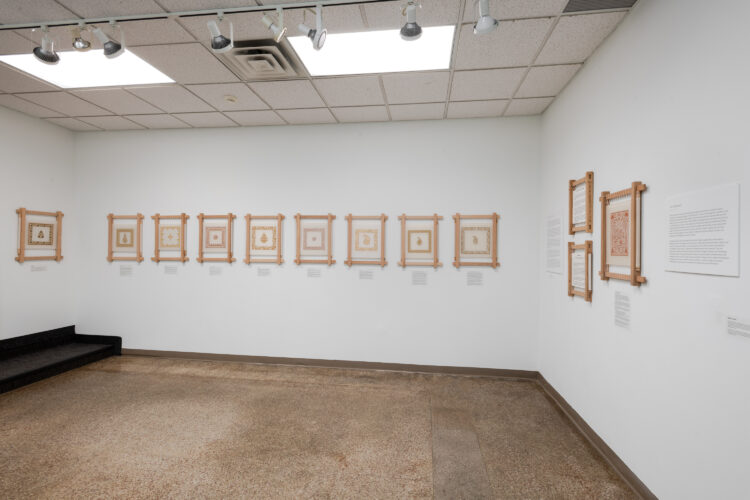
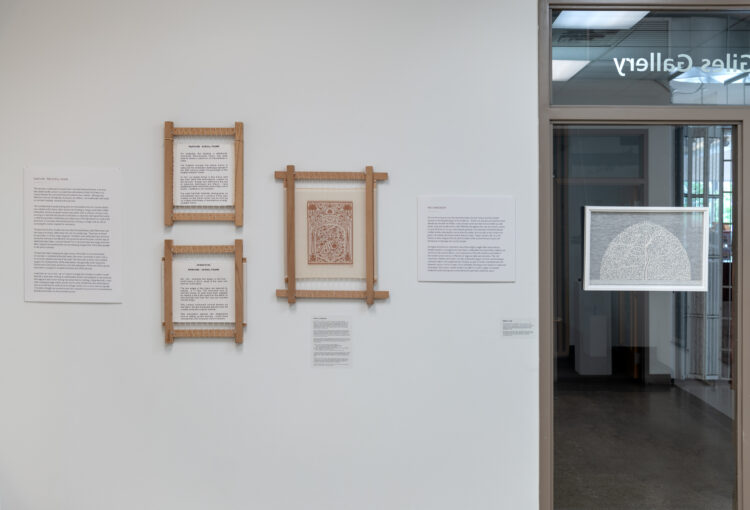
Photos by Rik Sferra
______________________THE EMBROIDERY_____________________
source: http://www.youtube.com / Art Speaks: Resurgence with Asif Shaikh
One of the most precious links between India’s ancient history and the present moment is the living heritage of her textile art – those rich and glorious traditions that effortlessly interlink the Maker, myths, human hands and time honored skills as weft meets warp and needle meets cloth. Manifest throughout this vast and varied country is a rich diversity of woven, embroidered, printed, resist dyed and embellished handcrafted textiles intended for use as attire for deities and mortals, as decorations for places of worship and homes and as items of trade. Today’s textiles still carry the history of early cargoes that set sail from India to the ancient Roman Empire, the Indonesian archipelago and courtly Europe.
Amongst those historic shipments were India’s highly sought after embroideries. Initially created to strengthen and join fabrics, embroidery has been finely crafted over time for its decorative effects, as an expression of the skill, creativity and belief of the needle worker and as a reflection of regional styles and variations. The rich repertoire of Indian embroidery includes a beautiful range of stitches and techniques worked on fabric with supplementary threads, as well as further embellishment with elements such as mirrors, metals, coins and shells. Drawing on the wealth of traditional techniques, 21st century needle workers are able to create a range of exquisite traditional and contemporary embroideries for garments and home décor.
________________________AARI on KARCHOB______________________________
The karchob is imperative in order to create fine quality embroidery. Basically two types of embroidery can be done on the karchob; Aari (chain stitch) with silk and metal thread (kasab / kalabattu) with a number of variations in the stitch and Zardozi with metal threadand other elements once again using a variety of stitches. Aari work is executed with the aari needle, a fine awl similar to the European tambour hook, while zardozi is executed with a regular needle.
The aari needle has a notch incised just above its point and this forms the hook. The thread is held under the fabric, the aari needle is pressed through the fabric to take up the thread and pull it through to th e upper surface thus forming a small loop. The tip of the aari needle is then inserted through the loop and into the fabric once again and the process is repeated to form a continuous line of chain stitch.
Chain stitch remains the most popular stitch worked with the aari needle and several stitches can be developed from this. Basic chain stitch can be worked with single, double, three and four ply threads which make stitches of varying fineness.
Stitches that can be worked with the aari needle are:
- Bal taka – twisted chain stitch creating a knotted effect
- Batt – close lines of chain stitch to fill shapes
- Jali – a netting effect created by pulling threads with the aari (different effects are created by varying the stitches)
- Lote – closely worked, long chain stitch similar to satin stitch
A variety of threads including cotton, silk, wool and metal are used to create embroidery with the aari needle. According to the thickness/fineness of the thread an aari needle of suitable thickness/ size of notch is selected for the work.
Pitta work is aari embroidery using metal threads. When the motifs are completed the metal thread is gently tapped with a small wooden hammer. A wooden dabber is held below the surface of the fabric to support the embroidery, to smooth the work and give it a soft sheen.
The aari needle is also used to secure beads and various elements such as sequins onto the fabric using fine stitches.
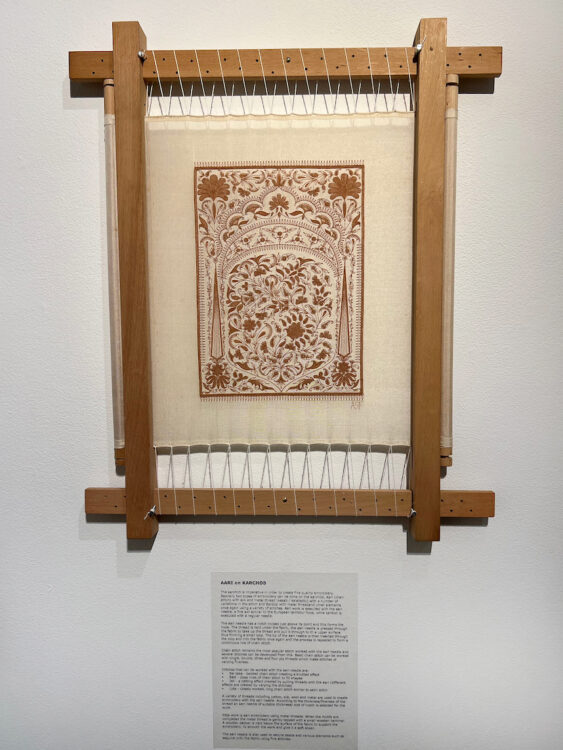
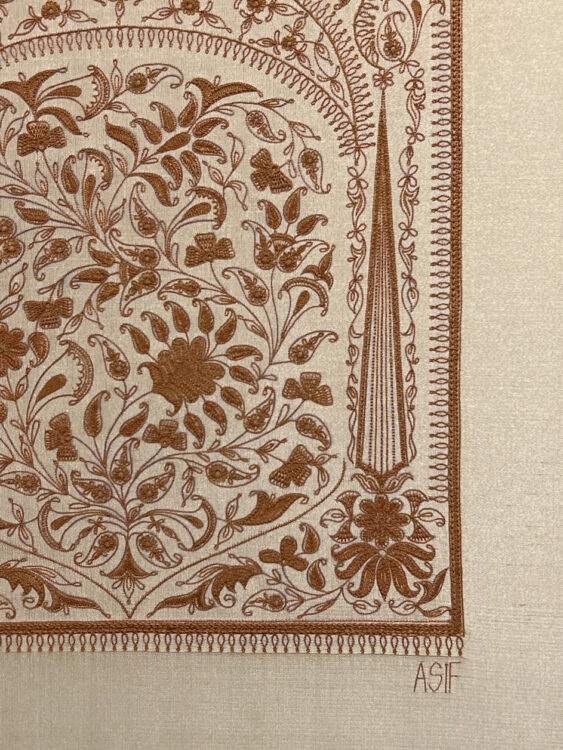
________________________________AJRAKH___________________________________
Ajrakh is a multi-layered resist block printing technique. This exquisite example is created with the use of natural dyes on a base of gajji silk.
In this piece, the all-over design is of a repeating star-like pattern and is embellished with aari embroidery. With the use of sequins and gold thread, the aari embroidery highlights a lattice pattern (jaali) seen at the top and bottom borders. The gold stitch work and sequins are also incorporated into the central field, emphasizing the star motif.
The ajrakh on the silk fabric is the work of Abdul Jabbar Mohammad Khatri of Dhamadka.
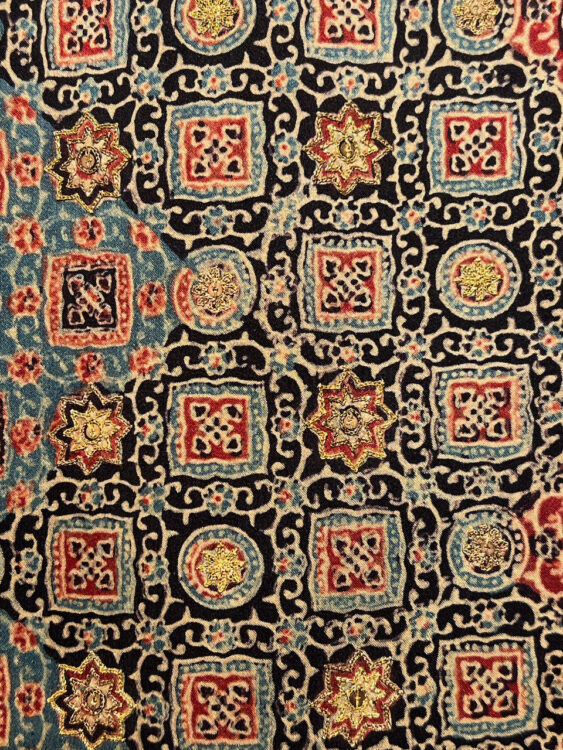
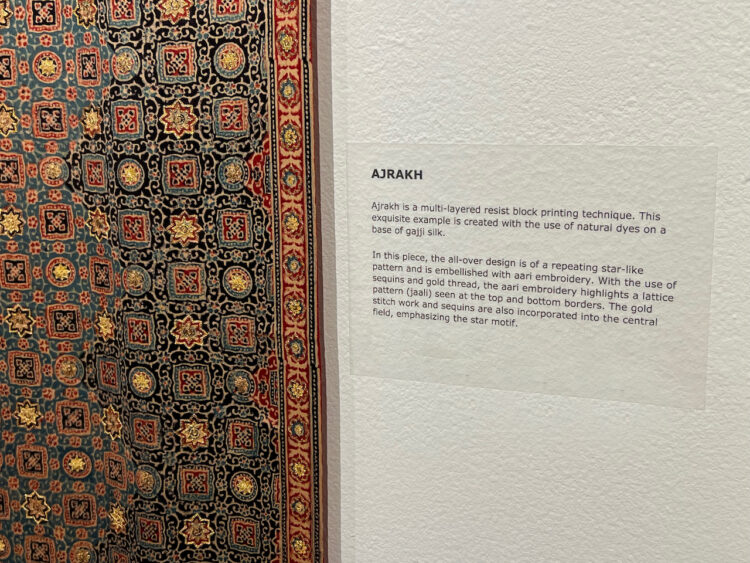
____________________BANDHANI (with Aari Pitta Embroidery)_________________
Bandhani is a resist tye-dye technique created by tying tiny knots on fabric. The detailing on the sleeves and base of the skirt show aari pitta embroidery using metal threads.
When the embroidered motifs are completed, the metal thread is gently tapped with a wooden hammer. A wooden block is held below the surface of the fabric to help support the embroidery. The tapping smooths the stitches and gives the work a soft sheen.
The observe of sash is embellished with parallel aari chain stitching and a smaller aari pitta motif on the reverse.
The bandhani on the silk fabric is the work of Abduljabbar and Abdullah Khatri and the artisans of SIDR Craft studios, Bhuj, Gujarat, India.
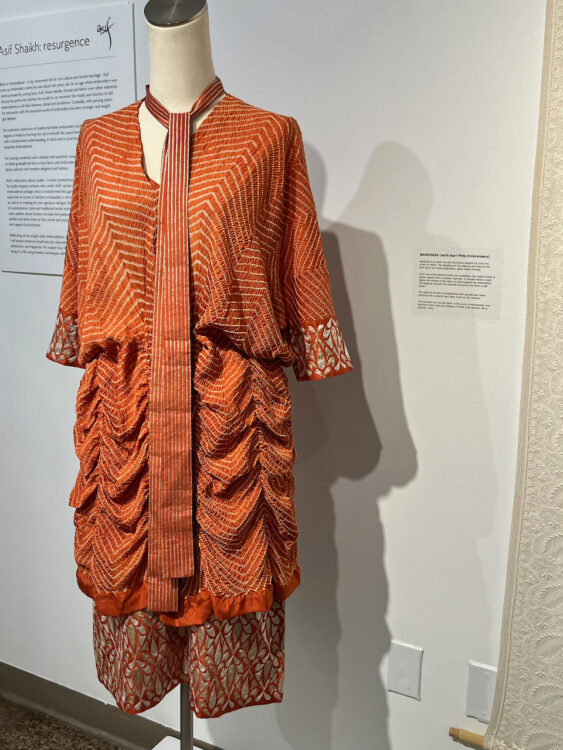
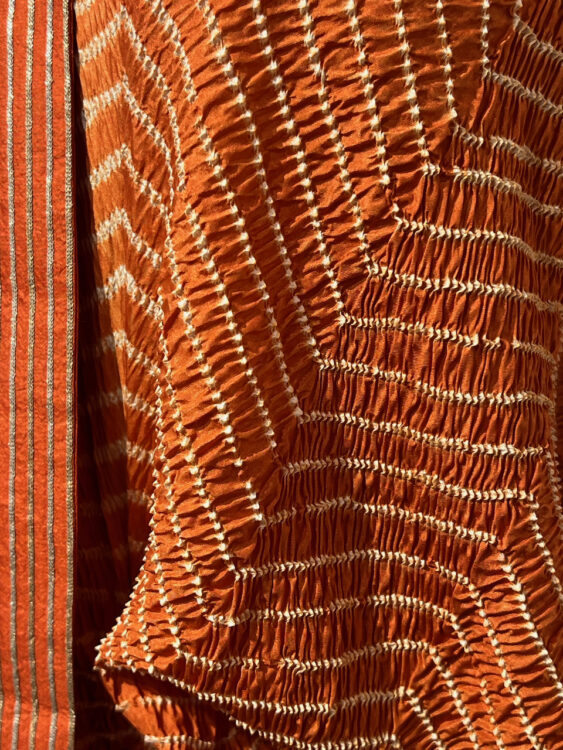
______________________________CHIKANKARI_________________________________
Chikankari is a subtle, sophisticated style of embroidery worked with white cotton threads on fine white cotton fabric using a round frame. This ethereal needlework, often referred to as ‘shadow-work’, was perfect for embellishing summer attire for royalty families.
The technique and skill of chikankari remains Lucknow’s forte, and is passed down through the female line. Chikankari was traditionally worked on very fine muslin, making the embroidery appear to be a part of the fabric. Motifs are stamped on the fabric with small wooden blocks dipped in colour that is washed off after the embroidery is completed.
The motifs are generally floral and paisley in design. Each pattern is designed in such a way that it seamlessly forms part of the garment in terms of size, shape and placement. Since the colour palette was traditionally limited to white on white, it was through the incorporation of different stitches that varied effects were created.
Chikankari comprises six main stitches – taipchi, bakhia, khatao, murri, phanda, jali, and their variations. Some on the reverse, while others pull the threads to create a ‘jali’ (net). A garment or textile frequently incorporates more than one of these stitches. To create a rich formal look, kamdani and fardi are added to chikankari.
The delicacy and fineness of chikankari is dependent on the care and patience of the artisan. One garment can take months to complete.
This work is stitched on fabric woven by the artisans of Bhairvis Chikan, a cooperative textile center founded by Mamta Varma, in Lucknow, India.
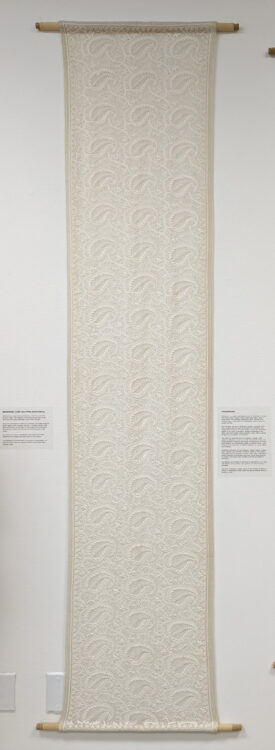
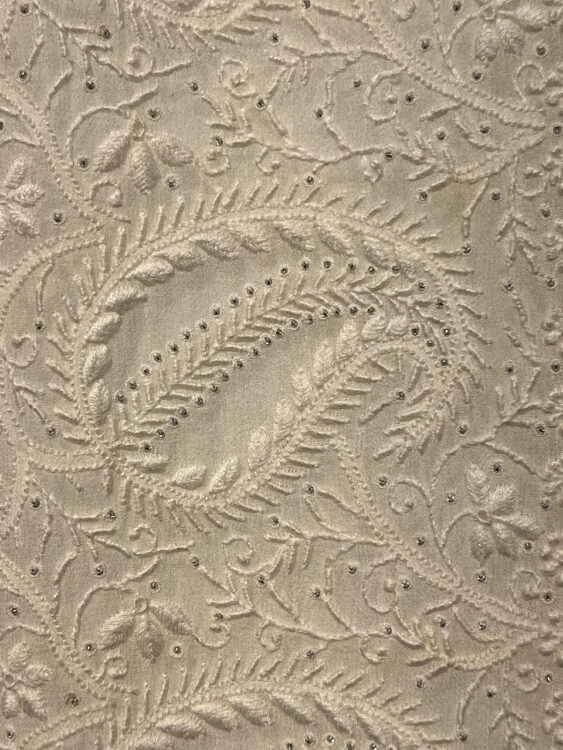
___________________________DANKA EMBROIDERY_________________________
Danka embroidery is practiced in Udaipur by the Bohra community of Rajasthan and is named after the square pieces of gold plated silver foil used in its creation.
Danka squares are made from thin sheets of polished silver which are gold plated, cut into shape and then further hammered to obtain the curved surface typical of this embroidery.
The squares are arranged into motifs and multiple strands of metallic thread are couched on the edge of the danka using the tool called fatila. The tip of the motif is usually finished with a loop couched onto the fabric.
Danka embroidery can be further embellished with metal aari, sequins, dabka, nakshi, and beads.
The motifs used are inspired by nature and include paisley, flowers, peacocks and the sun and moon.
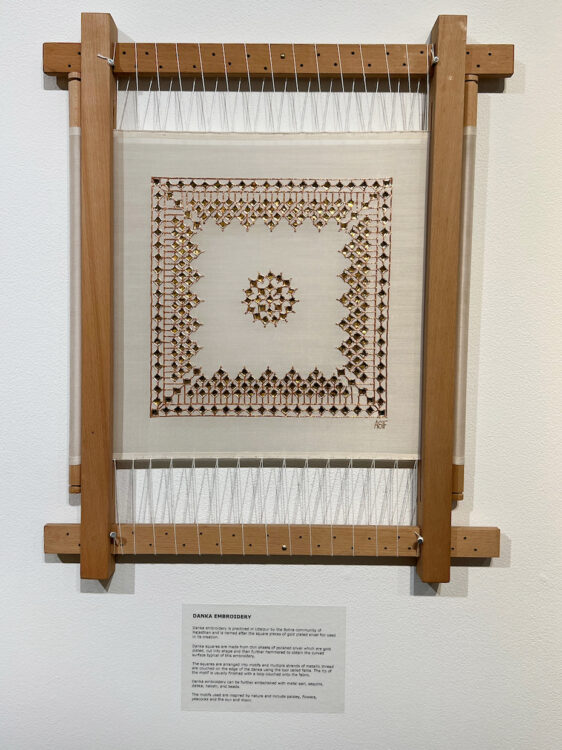
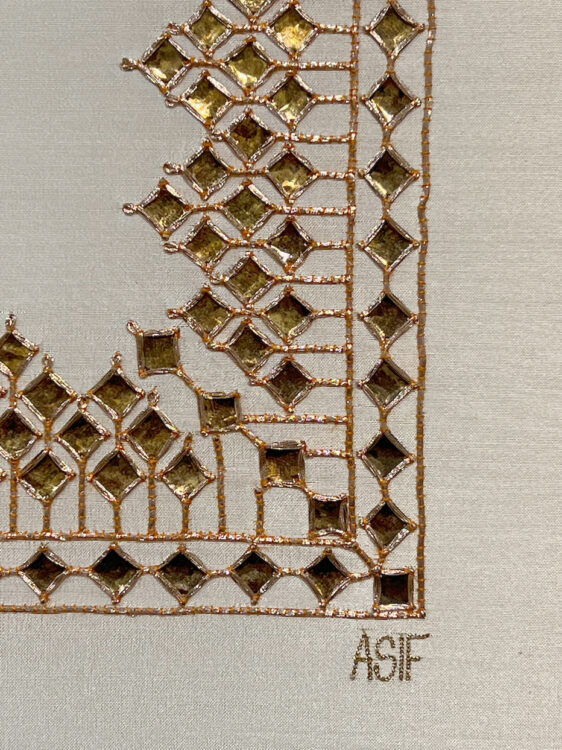
_______________________________DOKH______________________________________
This embroidery, using floral and geometric motifs, is executed on thick fabrics including velvet. In past centuries, Dokh embroidery was mainly used in furnishings, carpets and flags.
Different metal threads including badla are used to create dokh. Essential to this embroidery, a foundation padding up to one inch in thickness is created by the use of soft thick cotton thread. The raised surface at the center of the floral motif gradually tapers down to its pointed edges.
These padded surfaces are then covered with thick metallic thread using a ‘fatila’. This one-inch square wooden bar measuring 6 inches in length is the exact size and weight required to prevent the threads from becoming entangled.
The edges of the shapes are finished with couching using an ‘S’ twist. The overall appeal of dokh embroidery is its elegant embossed surfaces.
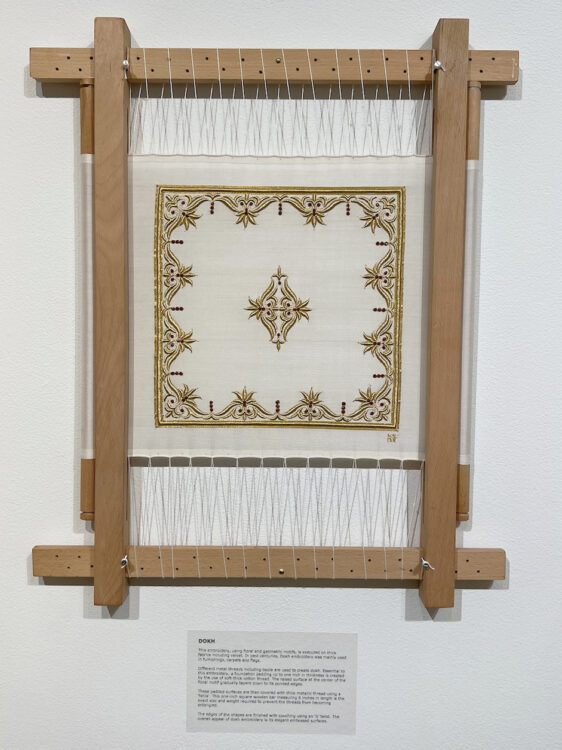
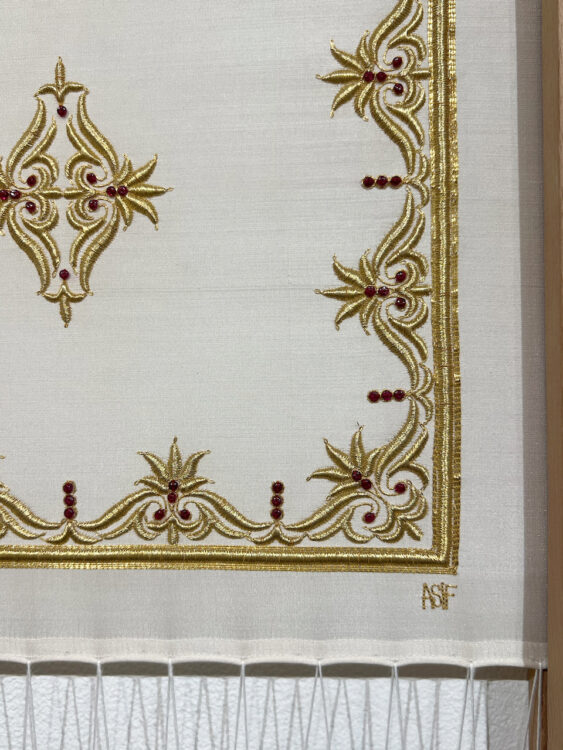
__________________________________GIRAH_________________________________
Girah is a type of surface stitch commonly associated with Chikankari embroidery from the Lucknow community. Also known as pipal girah, the stitch is similar to what we in the West would know as the French knot.
To obtain the variation in the design, two types of girah are employed; traditional girah and chhalle girah. Traditional girah gives a tighter, more controlled stitch, as seen in the center of the flower, and chhalle girah gives a looser, more relaxed stitch, as seen in the petals.
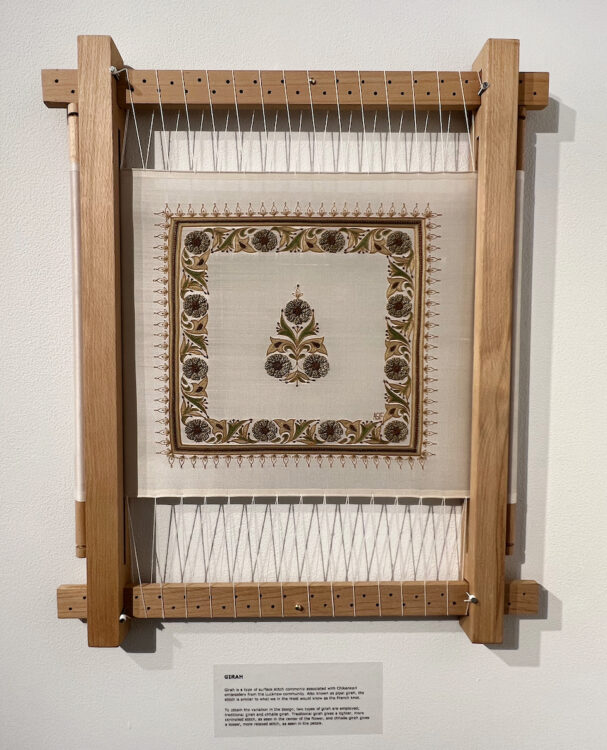
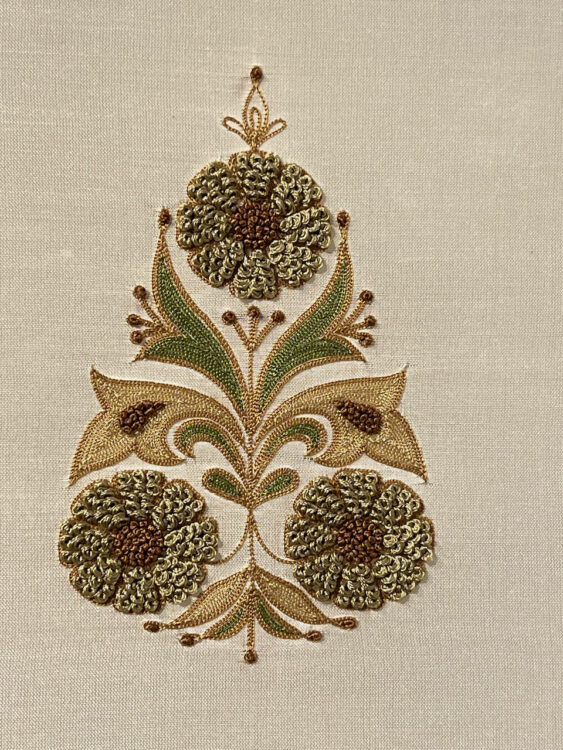
_______________________GOTA PATTI EMBROIDERY__________________________
Gota is a flat woven ribbon that uses thin strips of gold/silver wire in the weft and silk/cotton in the warp. It is mainly woven in Surat and in Ajmer (Rajasthan).
Gotta ribbon is used as a decorative element on textiles and is practiced mainly in Jaipur in Rajasthan. The motifs are mainly inspired by nature and include plant forms and stylized paisley.
To create the motifs, different shapes of cut pieces called ‘gota patti’ are sewn together. The cut ‘gota patti’ is first attached to the base fabric and then couched with multiple strands of metallic threads using the fatila. Further embellishment is created by the addition of various metal elements such as beads and sequins.
This type of embroidery is generally used to cover larger surfaces of textiles and thus giving a heavy look while remaining light weight.
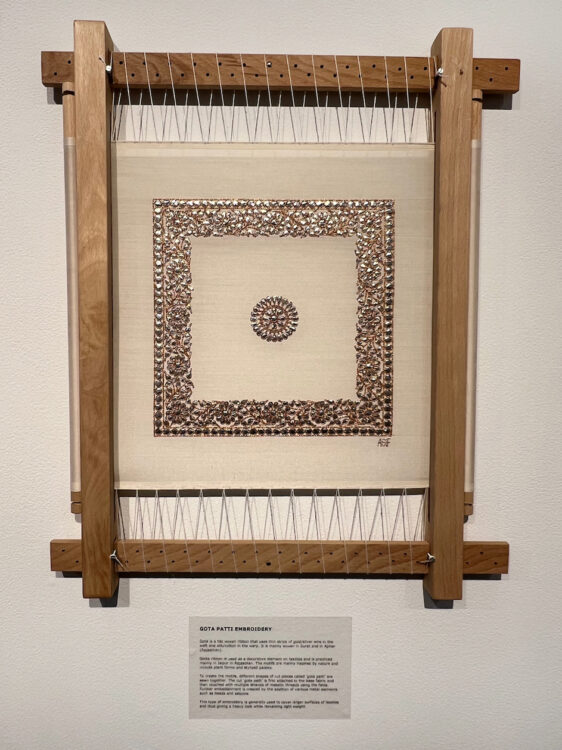
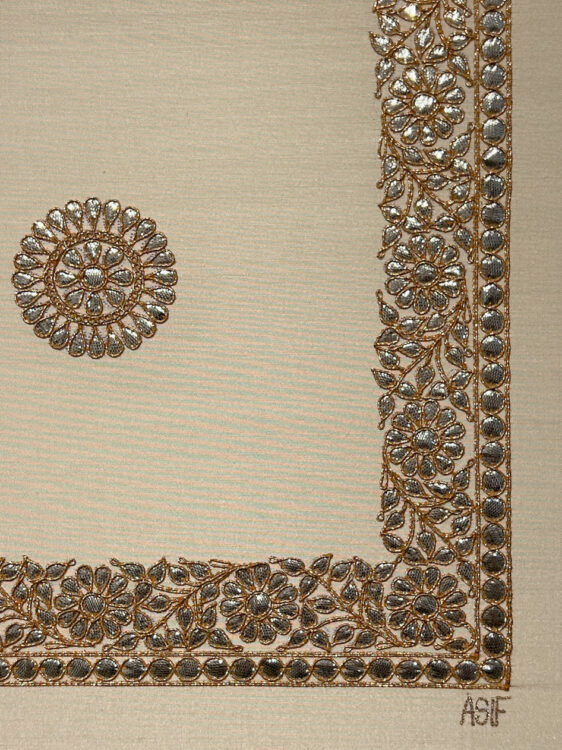
__________________________________KAMDANI________________________________
Kamdani is one of India’s most beautiful and versatile embroideries worked with badla or flat metal strips to create a dressy and sophisticated look. While zardozi tends to be heavy with its metal threads and elements, kamdani is lighter as it is worked with only one element – badla.
In kamdani, the badla is used like a thread to create stitches.
To begin embroidery, the embroiderer threads a thick needle with a short length of thread making a small loop towards its end. One end of the badla is then attached to the loop. The needle is slipped in and out of the cloth in a continuous movement and the badla is pulled along with it. Only a small amount of the badla is then visible on the upper surface of the fabric. The end piece of badla is then turned under in order to secure it, while the needle is once again pierced into the fabric and stitch is continued.
Kamdani requires a high degree of skill, as after a few stitches the badla tends to get twisted.
Treating the badla as if it were a thread, embroiderers are able to work a variety of stitches. Traditionally, floral motifs were most popular in kamdani with few geometric motifs. Different types of jalis can be created using badla, including wave patterns, parallel lines, stars and diagonals.
Badla is also used for making ‘fardis’ (small dots). Fardi is created by knotting a short length of badla. The process is repeated to fill the space. For fardi a flat thick needle with two eyes is used to take the badla through the fabric.
Fardis are an effective way of embellishing a textile. Dots can be placed in patterns and combined with other textile techniques such as bandhani, chikankari, and printed or woven textiles to enhance their beauty. In this way badla can be used to create rich, formal and elegant work on clothing.
After the work is completed, the embroidery is placed against a hard surface and the reverse side is very gently rubbed with a cowrie shell to smooth the work and flatten the badla against the fabric.

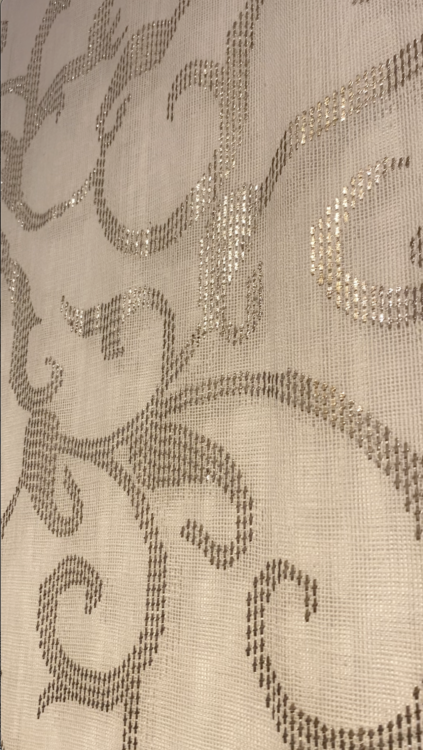
_______________________KARCHOB – THE SCROLL FRAME__________________
The karchob, a traditional, horizontal, floor-mounted hardwood frame, is the tool that assists needle workers to create fine embroideries. In fact, this frame is so closely linked to the work itself that embroideries thus created – although very different in the use of materials, techniques and effects – are traditionally referred to as ‘karchobi’ meaning `worked on the karchob’.
The word karchobi instantly distinguishes an embroidered work as it conveys that it was created on this frame rather than by hand holding or using a small frame. While embroidery can be executed in various ways either with or without a frame, it is by working on a karchob that the art of embroidery is extended well beyond that which is otherwise possible. Furthermore, as it allows up to 20 embroiderers to work at the same time on one piece, the karchob permits working on a large scale as well as producing the volume required for commerce.
The karchob has four wooden bars; two short horizontal bars called Shamsheer and two long vertical bars called Adda that rest on wooden legs. These bars are fixed to each other on all four sides using nails. The fabric to be embroidered is stretched across the framework and affixed to the horizontal and vertical bars with the help of additional cotton fabric, cord and thread. This is the most important stage where the fabric needs to be attached with precision keeping the grain line of the fabric parallel to the bars of karchob.
The karchob helps in keeping the right tension of the fabric to be embroidered. As the fabric is stretched across the frame it becomes convenient to stitch, that is, to move the needle in and out of the cloth. The frame also provides much needed support for the hands/arms of the embroiderer who generally works long hours. Furthermore, both hands are free to work the embroidery. At the end of the day the embroidery in progress is wrapped around an arm of the karchob.
A karchob can vary in size – up to 3 metres in length and 1.5 metres in width. A small karchob is used when working on small textiles and this can be placed on any structure that supports each corner leaving the centre free for stitching. A large karchob is used when working on large textiles and the work is often divided between embroiderers who sit on the floor to work. Sections of large textiles such as saris, that are typically 5.5 metres in length, are worked on and then wrapped around an arm of the karchob to facilitate embroidery on the unworked section.
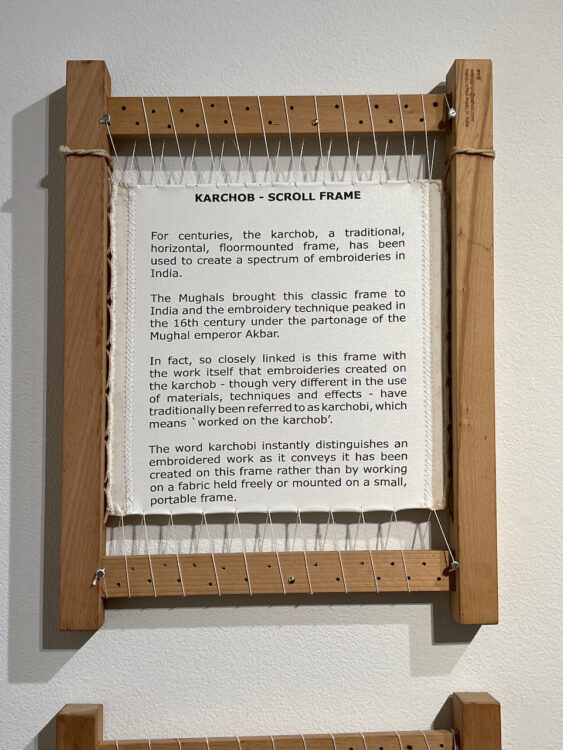
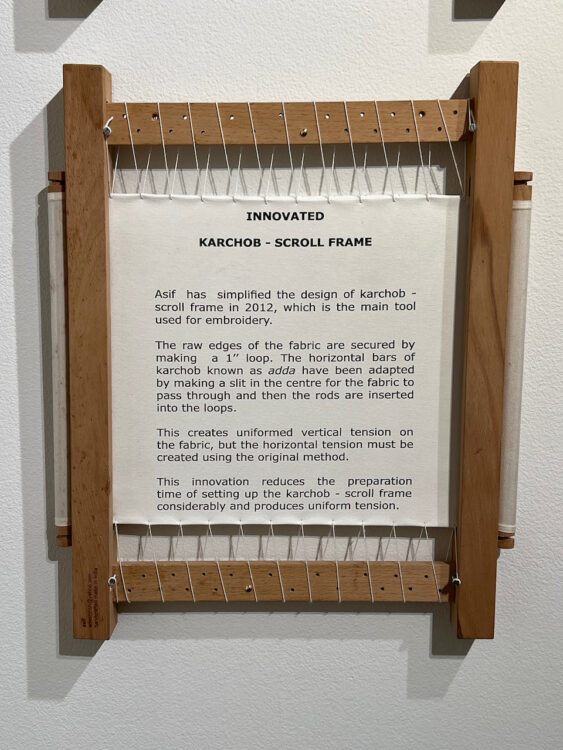
_____________________KUTCHI AARI EMBROIDERY, example 1____________________
One of the most fascinating historical and cultural inheritances of Kutch, a desert area located in the western most part of Gujarat, is its wealth of textiles. Kutch women traditionally create densely worked embroideries to beautify fabrics, create social wealth and express their skills and identities.
Kutchi embroidery features several stitches one of which is an adaptation of the cobbler’s stitch. This stitch, worked with an awl, was executed by ‘mochis’ (cobblers) to embellish leather goods such as shoes, bags, camel saddles and other articles. It is interesting to note that this technique was adapted over time for use on fabric and is now known as aari embroidery.
An entire spectrum of Kutchi embroidery is worked with the creative and skillful use of the needle without the use of frames. Exquisite and fine motifs inspired by nature, mythology and tradition are thus created.
Inspired by mochi embroidery motifs, Asif’s studio gives new dimension to this karchobi aari technique. Through the clever use of hue and shading, new looks and palettes are created. The most eminent aspect of this embroidery technique is the quality and depth created in the motifs which are further adorned with badla, beads and sequins thus creating contemporary and rich textiles.
Asif’s studio created a collection of Kutchi embroideries especially for the V&A Museum in London. This collection referenced motifs featured in antique aari embroideries exported to Europe in past centuries. The shapes, colors and proportions of the original motifs were refined by Asif to create the modern masterpieces.
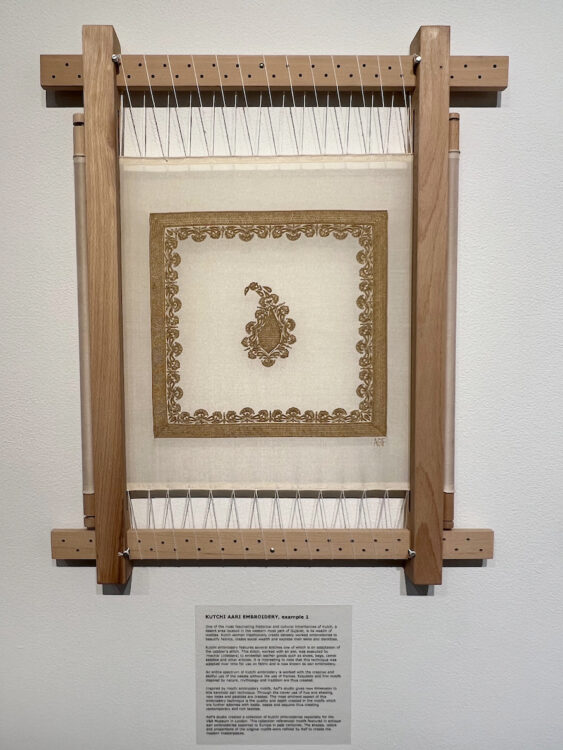
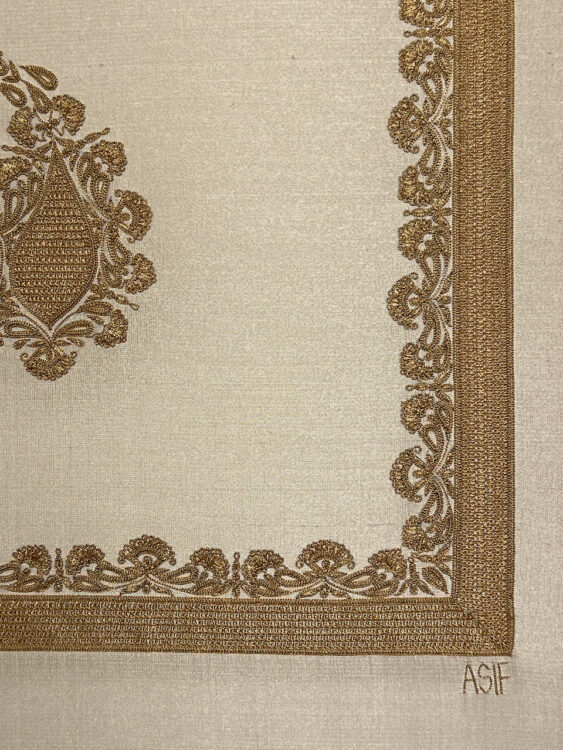
_____________________KUTCHI AARI EMBROIDERY, example 2________________
One of the most fascinating historical and cultural inheritances of Kutch, a desert area located in the western most part of Gujarat, is its wealth of textiles. Kutch women traditionally create densely worked embroideries to beautify fabrics, create social wealth and express their skills and identities.
Kutchi embroidery features several stitches one of which is an adaptation of the cobbler’s stitch. This stitch, worked with an awl, was executed by ‘mochis’ (cobblers) to embellish leather goods such as shoes, bags, camel saddles and other articles. It is interesting to note that this technique was adapted over time for use on fabric and is now known as aari embroidery.
An entire spectrum of Kutchi embroidery is worked with the creative and skillful use of the needle without the use of frames. Exquisite and fine motifs inspired by nature, mythology and tradition are thus created.
Inspired by mochi embroidery motifs, Asif’s studio gives new dimension to this karchobi aari technique. Through the clever use of hue and shading, new looks and palettes are created. The most eminent aspect of this embroidery technique is the quality and depth created in the motifs which are further adorned with badla, beads and sequins thus creating contemporary and rich textiles.
Asif’s studio created a collection of Kutchi embroideries especially for the V&A Museum in London. This collection referenced motifs featured in antique aari embroideries exported to Europe in past centuries. The shapes, colors and proportions of the original motifs were refined by Asif to create the modern masterpieces.
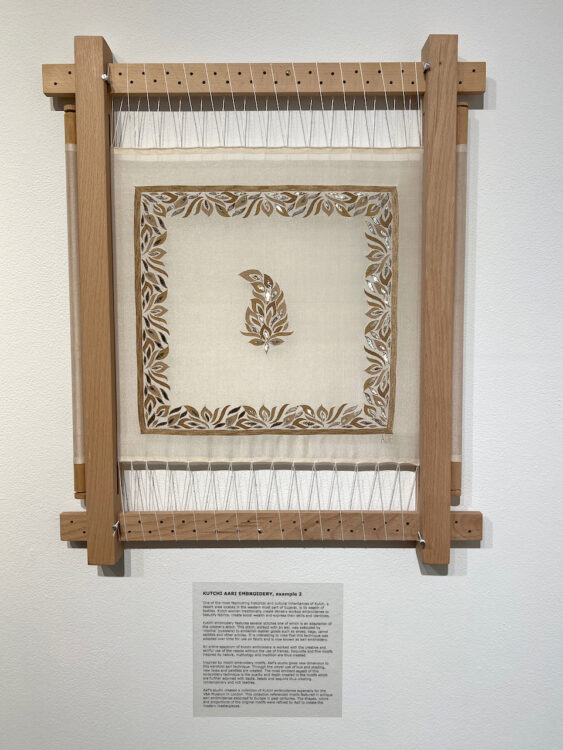
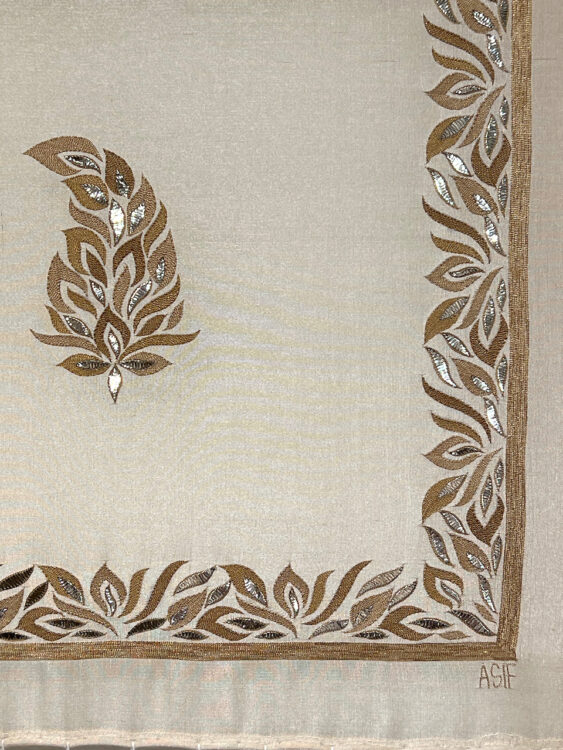
_____________________________MARODI______________________________________
Marodi, simply worked with twisted plied yarns, is one of the most eye-catching embroideries of North India.
The name ‘marod’ – meaning twist – explains the embroidery. The yarns are twisted manually to make a cord which is in turn used to create repeated loops that form a continuous line. The twisted cord is wrapped around a square 6-inch long wooden bar pointed at one end. Also known as fatila, this tool allows the cord to be uniformly tensioned and create loops of equal size. Furthermore, its pointed end shows the right direction for the loops to follow.
In marodi, couching threads are visible. The twisted cords are couched together with a contrasting thread to form ornate patterns. The cotton threads were traditionally dyed in saffron when used for gold and white cotton threads used for silver couching.
The motifs have a curved contour, usually forming a loop at the tip. Unlike zardozi, where the patterns are completely embossed, marodi features slightly open work. Badla, dabka, salma, and sitara are used for embellishment.
Marodi can also be executed with twisted silk cord.
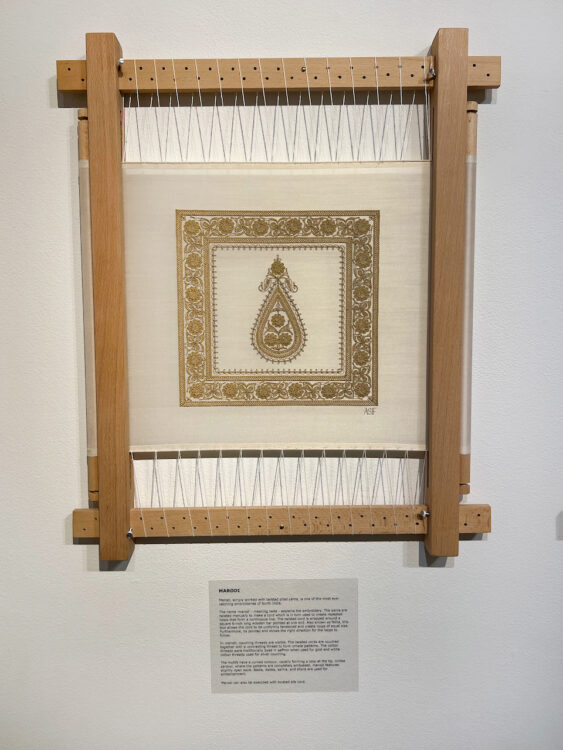
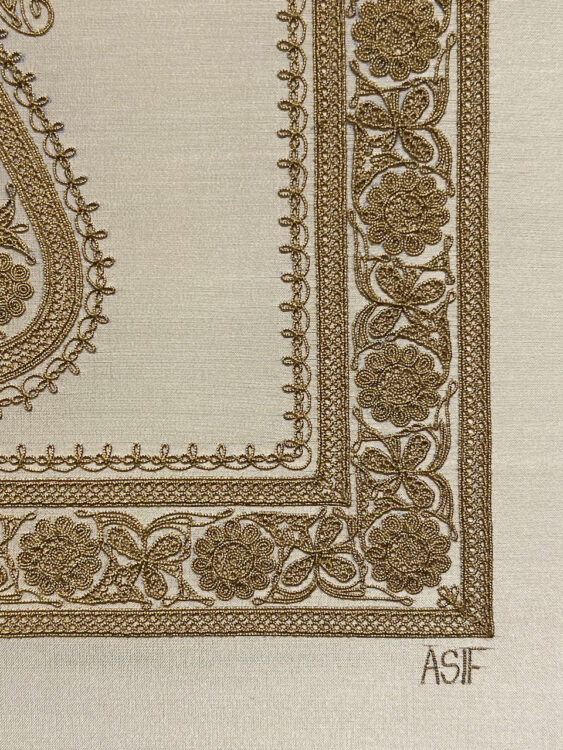
___________________________PARSI STYLE EMBROIDERY___________________
Originating in China, Parsi embroidery was noted for the use of different kinds of minute knots, satin, chain and couched stitch worked with silk, metal and untwisted silken floss yarn with the addition of beads and sequins.
Asif’s studio has simplified the technique of ‘khakha’ knots by employing ‘palti taka’ (reverse chain stitch) with the aari needle on karchob.
This new technique was created for the textile chapter of the UNESCO Parzor Project.
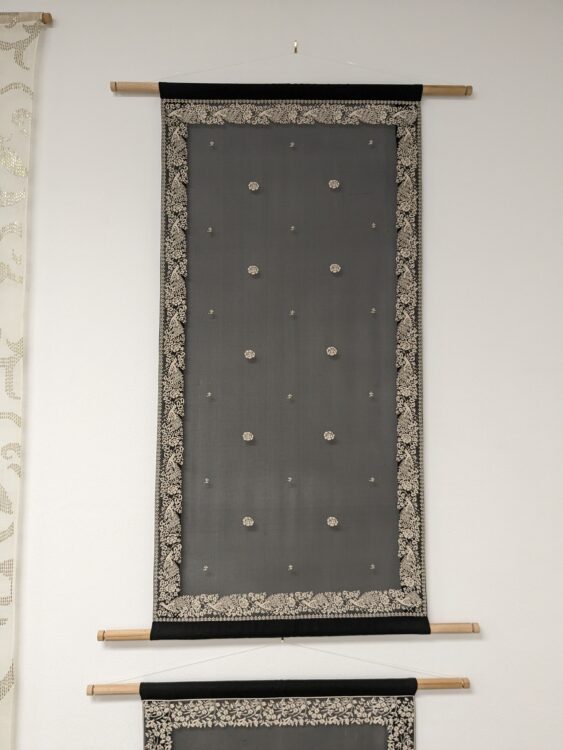
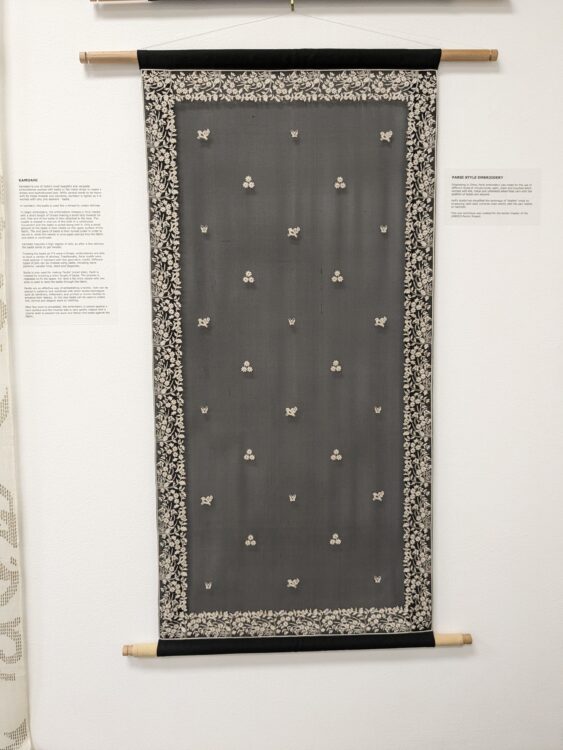
____________________________TREE of LIFE____________________________
This exquisite piece of needlework can be viewed from both sides. Similar to the Chinese form of Su embroidery, this double sided embroidery depicts the Tree of Life, found in the stone fretwork of the historic Sidi Saiyyed Mosque (built in 1573) Ahmedabad, India.
In the piece, the ground cloth is handwoven fabric made of silk and linen. The aari stitch, seen throughout the exhibit, is seen here crafted in fine silk, half the thickness of traditional embroidery thread.
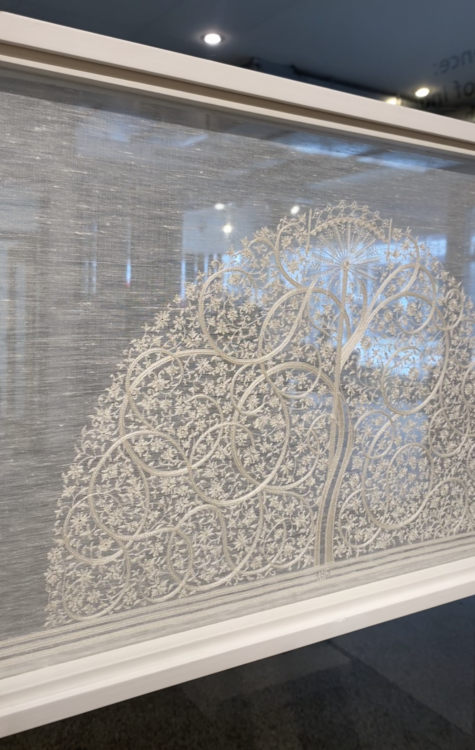
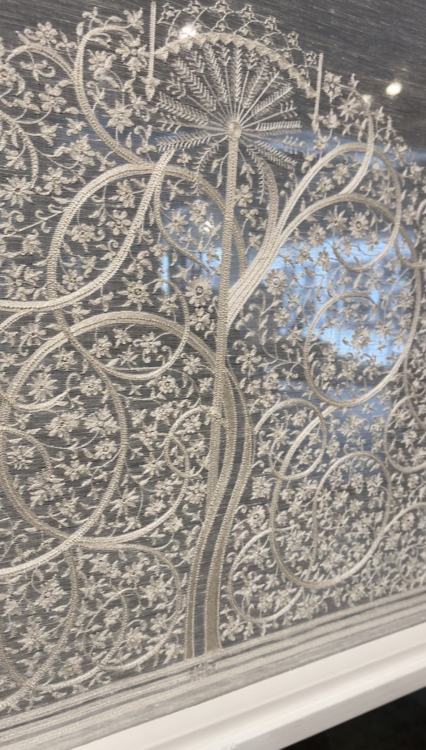
__________________________________VASLI_________________________________
Vasli embroidery is named after the paper that is used in its creation.
Vasli, a special paper used in miniature painting, has high archival properties making it favorable for use in embroidery. Several layers of paper are glued together using a glue made of a cooking flour that is not only free of synthetic chemicals but is also insect resistant.
Cut paper shapes of the specially designed motifs are stitched onto the fabric. Metal thread embroidery is then closely worked on the paper pieces. Metallic thread is couched on the edge of the paper shapes in an ‘S’ twist leaving a well defined edge. Multiple strands of metallic threads are used for this embroidery. The tip of the motif is usually finished by a loop that is couched to the fabric.
After the couching is completed the metal thread is gently tapped with a wooden hammer which compresses the stitch and gives a soft sheen. Further embellishment is created by the addition of various metal elements.
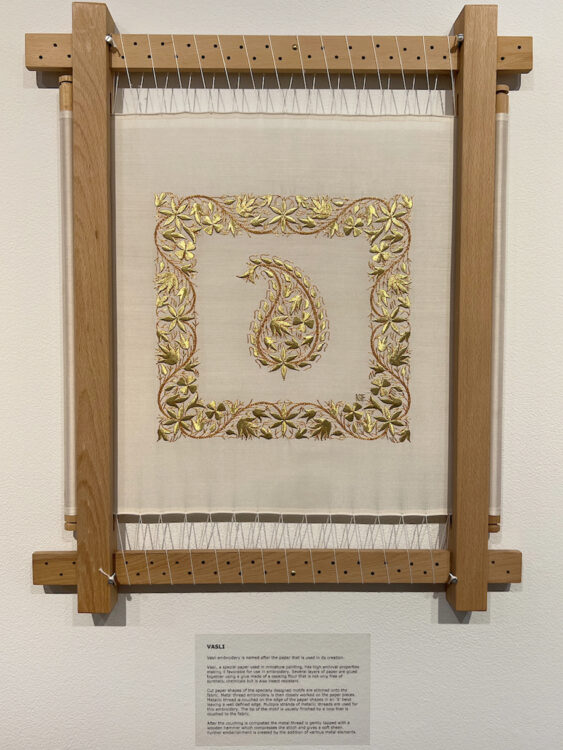
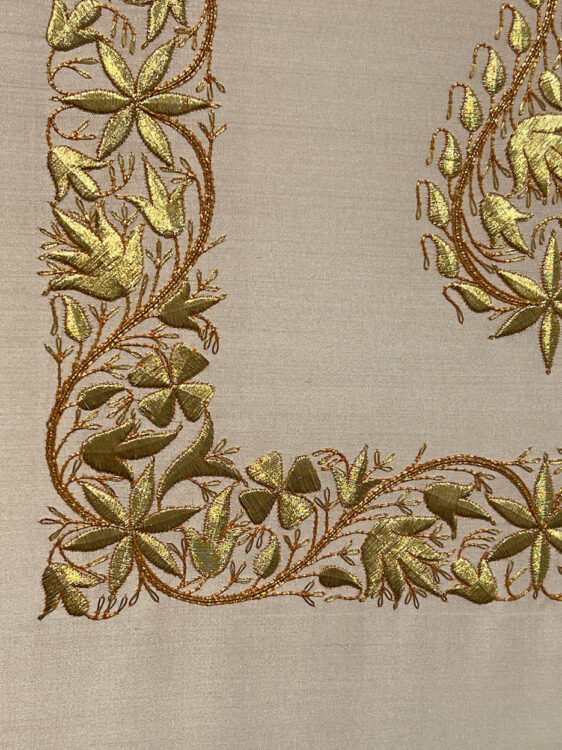
__________________________________ZARDOZI________________________________
Zardozi is derived from the Persian words ‘zar’ meaning gold and silver thread and ‘dozi’ meaning ‘karigari’ (craftsmanship). In zardozi, metal elements are threaded through a needle and the motifs are embroidered wholly or partially in different stitches such as satin, darning and stem stitches as well as couching.
As well as metal thread, metal wires of different shapes, size and thickness are cut into required lengths. Metallic elements such as kangani, dabka, badla, salma, and sitara are attached using fine stitches for embellishment.
The karchob is useful in creating zardozi embroidery. Metal elements to be stitched onto the work are placed on the stretched piece and thus easily taken up by the needle as the artisan embroiders the fabric.
Zardozi embroidery recreates the splendor of the textiles and garments created in imperial workshops during past centuries.
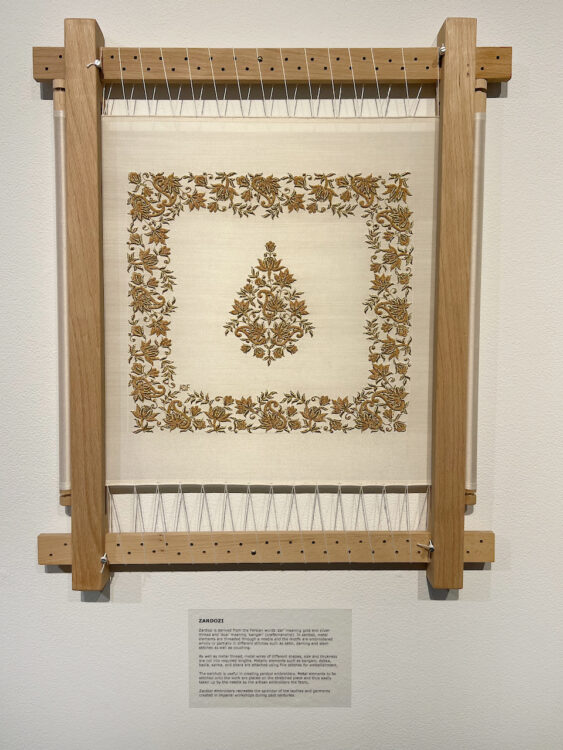
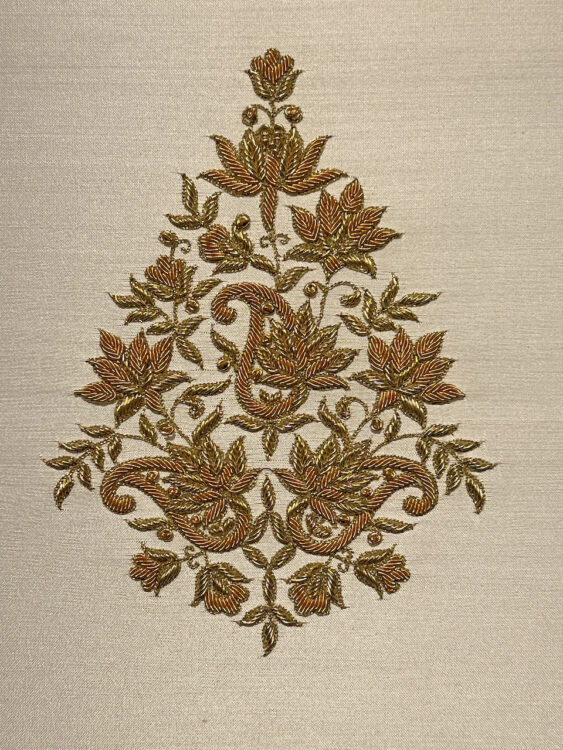
source: http://www.textilecentermn.org / Textile Center / 2023








